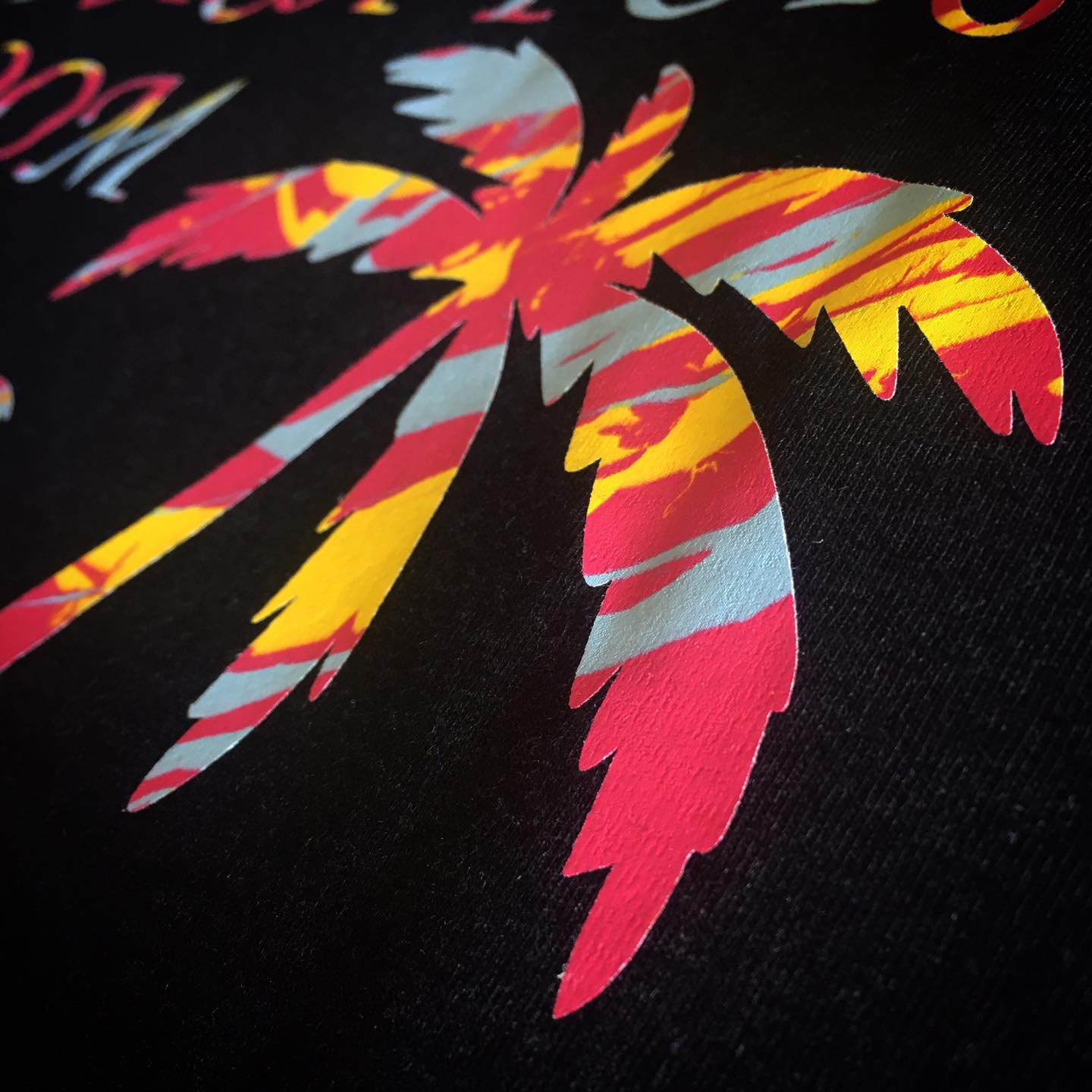Custom Screen Printing for Unique Promotional Merchandise
Wiki Article
Display Printing Uncovered: Everything You Need to Know Regarding Tee Shirt and Garment Printing Techniques
If you've ever before wondered just how those vibrant designs wind up on your favored t-shirts, you remain in the ideal place. Screen printing is an interesting technique that incorporates art with strategy, supplying limitless opportunities for creative thinking. Recognizing the principles, from devices to ink options, can substantially influence your outcomes. All set to discover the vital components that make screen printing an art form? Let's discover the information that can raise your jobs.
The Basics of Display Printing: How It Works
When you plunge right into display printing, you'll uncover it's both an art and a science. At its core, display printing involves producing a stencil, or screen, that permits ink to pass with just in specific locations.Setting the screen over the fabric, after that use a squeegee to push ink through the screen onto the garment. Each action is necessary, and understanding them will certainly elevate your display printing abilities, changing simple garments right into unique, expressive items.
Sorts Of Screen Printing Strategies
When you realize the fundamentals of display printing, it's time to check out the numerous methods that can elevate your designs. One preferred method is standard display printing, where ink is pressed through a stenciled display. This strategy is terrific for strong, vivid shades. After that there's water-based ink printing, which offers a softer feel and is green, but it needs a various technique to treating.If you're intending for fine information, take into consideration discharge printing. This strategy removes dye from the textile, leaving a soft, classic look. Another choice is plastisol printing, recognized for its longevity and brilliant colors, making it a favorite for several brands. Experiment with halftone printing to create gradient impacts and complex layouts. Each method has its distinct beauty, so don't hesitate to try them out to discover what suits your design best!
Vital Tools for Screen Printing
To attain magnificent lead to display printing, having the appropriate devices is basic. You'll need a durable display printing structure, which holds the mesh that transfers your design onto the garment. Next off, purchase high-quality squeegees; these are essential for applying ink evenly throughout the screen. You'll additionally require an excellent direct exposure system to produce your displays, in addition to a washout cubicle for cleaning them after use. A trusted warmth resource, like a conveyor dryer or warm press, is crucial for healing your prints to guarantee long life. Don't neglect an appropriate work area, furnished with tables and storage for your supplies. Finally, protective gear, such as gloves and masks, will maintain you risk-free from chemicals and inks. With the right tools, you'll be well on your way to creating professional-quality prints.Choosing the Right Inks and Materials
When choosing inks and materials for screen printing, you require to consider the sort of ink that works best for your project. Believe regarding material compatibility to assure your designs look last and terrific long. Also, check out green ink alternatives to make your printing procedure extra sustainable.Kinds of Display Inks
Choosing the best screen ink is important for achieving lively, durable prints that meet your project's requirements. There are numerous kinds of screen inks to analyze. Specialty inks, such as metallic or glow-in-the-dark, can include special results to your styles.
Material Compatibility Considerations
Recognizing textile compatibility is important for attaining high-quality display prints, especially considering that different products respond distinctively to different inks. When selecting inks, consider the fabric type-- cotton, polyester, or blends. For cotton, water-based inks work well, providing softness and breathability. Polyester, on the various other hand, typically requires plastisol inks for better adhesion and dynamic shades. You could require to make use of a combination of both types if you're printing on blends. Always test your inks on sample fabric to ensure they stick correctly and preserve shade stability. Additionally, keep in mind that material weight and structure can influence the last end result, so choosing the appropriate ink and material combination is important for your task's success.Eco-Friendly Ink Options
Green inks are ending up being a prominent selection for screen printers who want to decrease their environmental effect while preserving quality. When selecting inks, consider water-based inks, which are much less hazardous and less complicated to clean up compared to typical solvents.Furthermore, try to find inks made from renewable energies, such as soy or vegetable-based options. By picking the right inks and products, you'll not only produce magnificent layouts but also add to a more sustainable printing procedure. Make the button, and your prints will certainly mirror your commitment to the setting!
Preparing Your Design for Display Printing

File Format Demands
To assure your design looks vibrant and sharp on fabric, you'll need to pay very close attention to submit layout needs for screen printing. Start with vector documents like AI or EPS, as they can be scaled without losing high quality. If you utilize raster pictures, go with high-resolution files, such as TIFF or PNG, preferably at 300 DPI. Avoid making use of JPEGs, as they can shed clarity when resized. Additionally, make certain your design has a transparent history to stop undesirable white edges on your prints. Ultimately, keep color modes in mind; CMYK is basic for display printing, so convert your RGB designs appropriately. By following these guidelines, you'll set your art work up for a successful print.Shade Splitting Up Methods
Color separation is an important action in preparing your style for screen printing, and understanding it can considerably improve your print quality. You'll need to damage your style right into specific shades, as each color calls for a separate screen during printing. This precision not only ensures precise shade representation however likewise enhances the printing process.Resolution and Dimension
Attaining the very best results in screen printing starts with guaranteeing your style has the appropriate resolution and dimension. Ideally, your art work must be at the very least 300 DPI (dots per inch) for sharp, clear prints. Your last item might look pixelated and less than professional. if you make use of lower resolution.When it involves dimension, think about the dimensions of your print area. Layout your artwork to match the last print size, ideally creating it in the actual measurements you'll be publishing. By doing this, you'll avoid any type of unforeseen scaling issues.
Constantly check your design in both vector and raster layouts. Vector graphics can be scaled without losing quality, making them ideal for display printing. Preparing appropriately will guarantee your design looks fantastic on every garment!
Step-by-Step Screen Printing Refine
Screen printing is a dynamic procedure that enables you to produce lively styles on numerous surfaces. To obtain begun, you'll require a display, solution, and your chosen ink.After rinsing the unexposed emulsion, your display prepares. Establish it up on your printing surface and straighten your garment underneath it. Put ink onto the screen and make use of a squeegee to press the ink through the pattern onto the fabric. Raise the display thoroughly and let the print completely dry. Heal the ink utilizing warm to guarantee durability. That's it! You've efficiently screen printed your style.
Tips for Successful Display Printing Projects
While you're diving right into your display printing tasks, bear in mind that preparation is crucial to success. Beginning by collecting all your materials-- inks, screens, mops, and garments. A tidy office assists prevent unwanted mistakes, so clean up prior to you begin.Following, validate your artwork is high-resolution and effectively sized for your garment. Examine your display for correct direct exposure and clean it completely to prevent smudges. When mixing your inks, adhere to the supplier's guidelines to achieve the right consistency.
Throughout printing, apply even pressure with your squeegee for constant results. Do not hurry; take your time to verify each print satisfies your criteria. After printing, let your garments dry entirely before dealing with or packaging them.
Finally, constantly maintain an example of your work for future reference. By doing this, you can evaluate your development and enhance your methods over time. Happy printing!

Regularly Asked Questions
How much time Does It Take to Establish up a Screen Printing Work?
Setting up a display printing job typically takes around thirty minutes to an hour. You'll prepare the screens, mix inks, and adjust the press. The moment differs based upon complexity and experience, so stay arranged!Can I Print on Different Fabric Enters Making Use Of the Very Same Technique?
Yes, you can publish on various fabric types utilizing the exact same technique, however you'll need to adjust your settings and inks. Some textiles soak up ink in a different way, so experimenting assurances the very best outcomes for each product.What Prevail Errors to Avoid in Display Printing?
silk screen printing When display printing, stay clear of typical blunders like making use of the wrong ink, ignoring proper exposure times, or skipping pre-press checks. Always evaluate your setup and preserve clean screens to ensure quality outcomes each time.Exactly How Can I Correctly Clean and Keep My Screen Printing Equipment?
To effectively clean and keep your screen printing tools, you must regularly clean screens with ideal solvents, inspect mops for wear, and assure all devices are saved dry and dust-free. Consistency boosts and protects against costly repair work performance.Is Screen Printing Eco Pleasant Contrasted to Other Methods?
Display printing can be much more ecologically friendly than various other methods, particularly if you use water-based inks and eco-conscious products. By choosing lasting supplies and methods, you minimize waste and decrease your influence on the earth.Screen Printing Uncovered: Every Little Thing You Required to Know About T-Shirt and Garment Printing Techniques
At its core, display printing entails producing a pattern, or screen, that allows ink to pass with just in details locations. Position the screen over the textile, then utilize a squeegee to push ink via the screen onto the garment. One popular approach is typical display printing, where ink is pushed with a stenciled display.When choosing inks and products for display printing, you need to take into account the type of ink that works finest for your job.
Report this wiki page